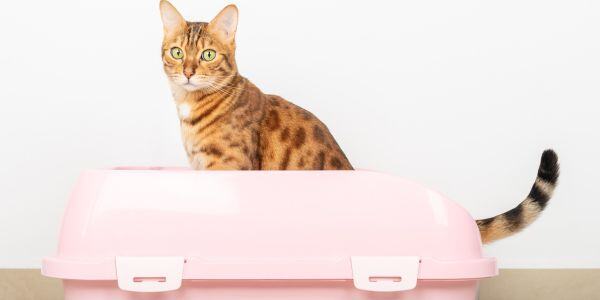
We have a lot of articles on this site dedicated to litter boxes, litter, house soiling, spraying, and other things related to the backend of your cat.
That’s because they’re incredibly important.
That backend can cause a lot of stress for you and your cat if it’s not getting what it needs. (Yes, your cat’s backend has needs.)
How you set up your cat’s litter boxes falls into this category. Let’s talk about it.
Why Litter Box Setup Matters
Instinctual needs. Safety and security. Personal preference. There’s a lot connected to your cat’s litter box experience. If you can meet their instinctual needs, ensure they feel safe using the box, and cover any of their quirky preferences, good things happen.
-
Your cat’s stress level will drop.
-
They’ll be less reactive to other pets in your home, improving relationships.
-
Their quality of life will improve.
-
The chances of house soiling due to litter box issues drop dramatically.
House soiling is one of the biggest reasons cats end up in shelters or are forced to live outside. That’s an awful shame because there’s always a reason a cat is soiling. It’s usually something we did, didn’t do, or could easily do but aren’t.
At least half of my behavior consult clients are dealing with house soiling issues. Litter box setup (along with your box and litter choices) are some of the easiest and most effective ways to manage soiling or, better yet, keep it from happening in the first place.
Litter Box Type and Litter Options
We cover litter boxes in this article and talk about cat litter types here. Check these out as your first step. Then, you’re ready to dive into setup.
Number of Litter Boxes
The rule of thumb is to shoot for one more box than the number of cats. If you have 3 cats, you want 4 litter boxes. If you have more than 3 cats, you might need to get creative on placement because that's a lot of boxes. But it's worth it.
I know what you’re thinking. Why so many boxes? Don’t cats share? Yes, they do. Even cats who aren’t crazy about each other will often use the same litter box. It’s not about giving each cat their own litter box. It’s having enough to meet all their needs.
-
Some cats like to pee and poop in different boxes. Odd but true. That’s why even just a single-cat home should generally shoot for 2 boxes. And multi-cat homes need multiple options.
-
If one box is being used, stinky, inaccessible/not feeling safe, dirty, or otherwise unappealing, you want your cat to have other acceptable options — multiple litter boxes – otherwise, they'll choose a place to go that you don't approve of.
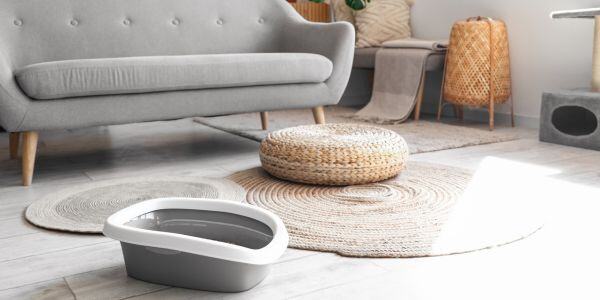
Litter Box Setup Guidelines
When it comes to litter box setup, we’re all somewhat limited by our space and what we can tolerate. Do the best you can with the space you have available.
Don’t be afraid to try different things if something isn’t working for you or your cat. And consider some things you might not have been open to in the past. Once you know the reason behind your cat’s needs and preferences, they carry a lot more weight.
Here are things to consider and avoid when it comes to setup:
Location
Spread litter boxes throughout your home. The goal is that if one box is unavailable, whether that’s because it’s being used or in an area that doesn’t feel particularly safe (for example, the room where your puppy is lounging or toddler is having a playdate), there’s another option in a completely different part of the home.
Try for at least one box on each floor. If your cat spends time on multiple floors, they should have access to a litter box on each floor. Nervous cats may limit how much they move through your home if they’re worried about getting too far away from their resources, like the litter box.
Watch out for roadblocks. Many households have multiple litter boxes. But they all end up on one floor of a multi-level home or in rooms down a single hallway. That means access to all boxes can be blocked if something is happening near the stairs or in the hallway.
This is particularly common in multi-cat households where there can be tension between cats. It can also come up if a cat is nervous around a dog or there are kids or people in the home who can be a bit louder. Your cat may not feel secure navigating past them to get to the litter boxes.
Watch for potential roadblocks and ensure you have boxes on both sides.
Avoid placing litter boxes side-by-side. Think back to why you need multiples: unavailable, stinky, unsafe, dirty. If all of your boxes are right next to each other, it negates the point of having more than one. If one stinks, they all stink.
If one is being used, your cat won’t want to get into a box right next to that one. If one seems less than safe, they all do. That’s because they’re next to each other. To your cat, that’s one big box with annoying obstacles in the middle of it.
Put some distance between boxes that are in the same room.
Boxes should be away from loud, busy areas but not completely out of the cat’s primary living area. Your cat may not feel secure using a box near the kid’s play area or the loud furnace that kicks on every hour. But they also don’t want to trek to the far reaches of the basement or attic where they wouldn’t normally spend time.
Look for areas in their zone but out of the main thoroughfares.
Open locations are best. Cats like open sightlines when using their box. They want to know if anything is coming or getting ready to pounce on them. They also don’t want to feel they can be easily trapped in a space. Placing boxes in larger rooms can feel safer than in smaller rooms like bathrooms or laundry rooms.
Having the box against a wall can provide some security on one side.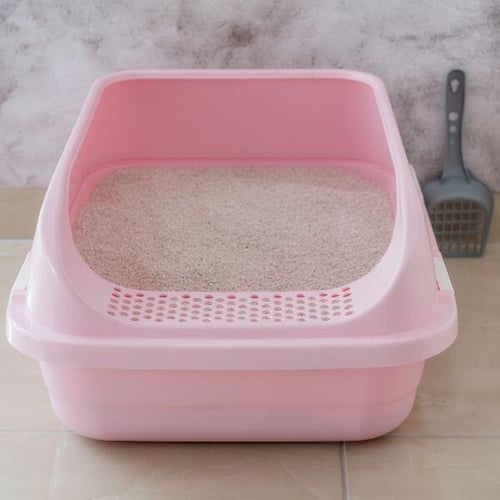
Watch for ambush points. If you have multiple cats, especially cats who don’t get along well, avoid placing boxes near ambush points like next to a cat tree or perch or inside a doorway where the other cat could be hiding around the corner.
Keep food and water away from litter boxes. Cats instinctually don’t want to pee or poop near a fresh water source for fear of contaminating it. And they wouldn’t pee or poop in their hunting ground because the smell can scare off potential prey and bring around potential predators.
Having the litter box near their food and water goes against those natural instincts and can make it a less-than-ideal place to do their business.
Test out different locations. If you have a box that never gets used, it’s probably in a spot that doesn’t work well for your cat. Move it to a different location and see if they start using the box.
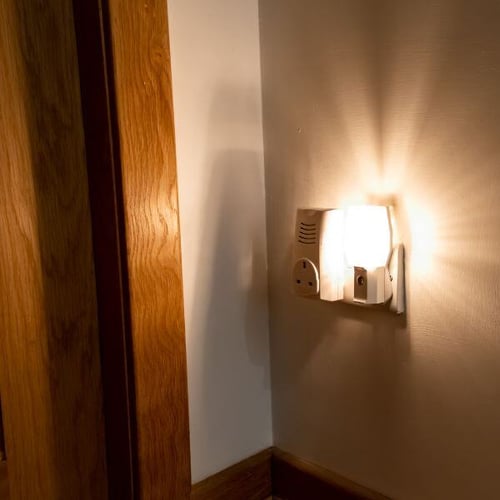
Visibility
Give them some light. Cats can see well in low light. But, just like us, their eyes need a little light. That means they can’t see well in heavy darkness. If your boxes are in rooms that get really dark, your cat may not feel safe using them.
This is especially true if the boxes are down a flight of stairs (in a dark basement is common), you have an anxious cat, there are other pets in the home that make the cat nervous, or your cat has mobility issues. They won’t venture into the dark if it doesn’t feel safe.
Try a simple, motion or dark-activated nightlight like this one that activates from 25 feet away.
Accessories
Skip the liners. I know they make cleaning up easier. But I’ve seen house-soiling cases caused by liners. Cats do a lot of digging in the box. Those liners can get caught up on their claws, which doesn’t feel natural. They pull up on the liner, and litter shifts around. It’s not ideal. Why give them reasons not to use the litter box, right?
Litter mats over plastic. A good litter mat or a shaggy bathmat like this one (my preference) are great to help catch stray litter and protect your floors. Avoid putting down heavy plastic, tarps, or other materials that can be crinkly and crunchy.
Most cats prefer not to walk on things that make noise or feel uncomfortable on their paws. If you need to protect your floor, try a carpet protector like this.
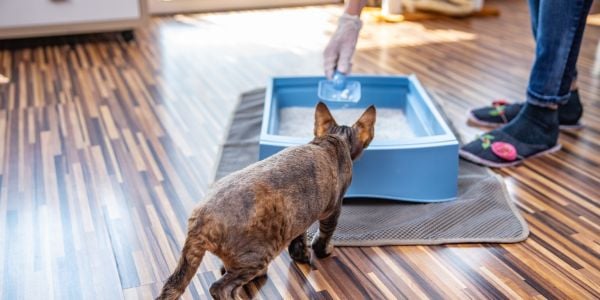
Again, we’re limited by our space, so you may not be able to follow all of these guidelines for every litter box in your home. That’s OK. Do what you can.
Try to provide alternatives where you can. For example, if you need a litter box in the cat playroom but the only place for it is next to the cat tree (a potential ambush point), make sure they have alternate box options in other rooms where you can avoid ambush points.
If the only spot you can fit a box on the first floor is in the laundry room (where it can get loud), make sure there’s an easy-access option on the second floor where it isn’t loud.
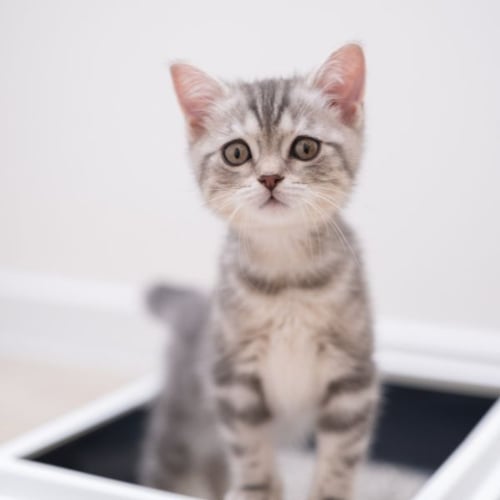
How to Get Your Cat to Use Their Litter Box
That’s an easy answer. You don’t. Cats instinctively look for someplace to pee and poop that meets the needs we’ve been covering here. If you provide it, they’ll generally use it.
Even kittens don’t really need to be litter box trained. They watch mom. If they don’t have a cat mom, you can put a little poop in the box to help them get the idea. But odds are that’s not even necessary. They’ll instinctively get in there, dig around, and realize it’s a great spot to do their business.
Show your new cat where the litter box is, let them investigate it on their own, and that should do it. If they aren’t using it, it’s probably because there’s something about the box setup that isn’t working for them.
Making Scooping Litter Easy
Scooping the litter box every day is your goal. You can make that task much easier by using a litter waste system. The Litter Champ and Litter Genie are great options. I personally preferred the Litter Champ because it’s a bit larger than the newer Litter Genie, and I liked the way the bags are installed and removed. But I’ve used and been happy with both. (The Litter Champ has, unfortunately, been discontinued).
Some of our team members have used a Diaper Genie because it's even larger. You don't even need to buy a new one, considering there are a number of sites where you can find used baby products, sometimes for free.
The idea behind these systems is that you don’t have to scoop and run out to the garbage can or dumpster every day. They’re the size of a bathroom garbage can. You put refillable bags in the unit. When you scoop, you open a series of doors, drop the waste in, and close the doors.
It keeps a week or more of dirty litter while managing the smell. When it’s full, you remove the bag, toss it in the garbage, and put a new bag in. Super simple.
Cleaning the Litter Box
It’s a good idea to dump and disinfect your litter box every couple of weeks or so.
Dump the litter that’s in the box. If you can access a water hose, you can spray out any remaining debris. If not, use your litter scoop to remove any stuck-on ick. Then, you can use a pet-safe disinfectant, following the manufacturer’s directions. Rinse if suggested. If you don’t have a hose, you may prefer to use a disinfectant that doesn’t require rinsing. Let it dry. Then, it’s ready to refill and use.
We have an article on pet-safe cleaners that you can check out, Cleaning Products That Are Safe for Pets.
The Tersano iClean® mini is a top pick and doesn’t require rinsing, uses water, and is 100% non-toxic to pets and humans. We offer a 10% discount; use code PETSAFE10 at checkout. You can see how our teammates use it and other litter box clean-up and odor solutions in this article, Easy Tips to Reduce Litter Box Smells and Messes.



